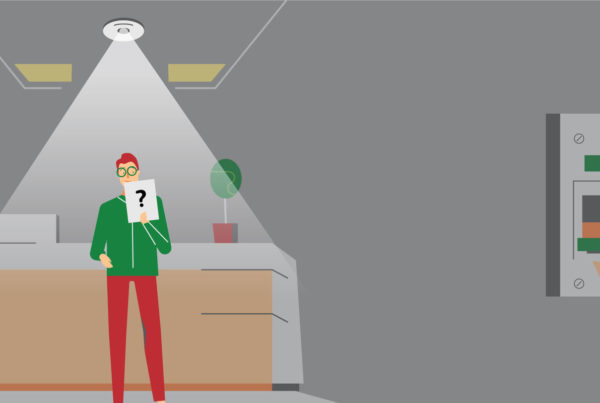A ground-breaking approach, using the Internet of Things (IoT), can help with many facility management tasks including monitoring energy and water consumption, fire prevention and building maintenance.
One sector where IoT can make a significant impact is in the field of healthcare helping to improve the quality of care and also reduce the cost of healthcare delivery.
What is the Internet of Things?
IoT consists of cloud-based software, hardware and sensor networks that enable interaction with and between devices and systems.
With IoT, devices and procedures are connected online anticipating the needs of its occupants or in the case of the healthcare industry, a hospital or medical centre. The complete integration of IoT into structures where we work or live creates spaces that promote efficiency and optimal resource use.
Challenges in current Health Care Delivery
Recent research suggests that 70% of individuals want their doctors to monitor their health remotely.
Furthermore, 81% of people under the age of 45 want to know more about IoT and share data with their doctors. These statistics show that both medical personnel and patients are becoming interested in the immense benefits of using IoT to improve healthcare delivery.
When it comes to offering high levels of patient satisfaction, the present method of healthcare delivery performs poorly, and resources are often not efficiently distributed. On several measures, healthcare delivery performs poorly. Patient satisfaction is low, waiting times for emergency care and admission continue to resources are not always used efficiently.
Patients miss appointments or visit the wrong department and those with less severe conditions flood emergency rooms assigned for life-threatening cases. Multiple handling of administrative paperwork leads to clerical errors resulting in inefficiencies and potential clinical mistakes. In term of facility management, energy costs are a high proportion of funds spent in the healthcare sector.
Between 2008-2009 and 2011-12, NSW health recorded a 47 per cent increase in the Energy cost ($81.8 million to $120.4 million). Their findings also showed that for a given unit of energy, the expenditure increased close to 51 per cent ($18 per gigajoule to $27 per gigajoule). Smart building technology using IoT can help reduce energy costs and free up resources for other services.
How Smart Buildings Can Improve Traditional Health Care Delivery
Provides Optimal Care for Patients
A medical centre transformed into a smart building could connect to a patient’s smartphone to guide them through the facility. Therefore directing the patient to the right department and even to the shortest queue at the reception or a free parking space. Patients could also receive and complete their forms before arrival and make payments quickly on departure.
Reduces Energy Consumption
Smart building technology can support the network of mechanical and lighting systems in the healthcare facility. It can adjust the internal conditions of the buildings such as switching off unused lights in empty rooms and increasing or decreasing the temperatures based on the occupancy of rooms.
Ensures Access Control in Sensitive Areas
Smart building technology also enables access control. This not only regulates entry into the facility but also ensures tracking and reporting of on-site activities. Access control provides a safe environment for patients, staff and visitors. With the presence of an automated system of designated sensors, access is restricted to those authorised to enter specific areas for a specified period.
Regulates HVAC Services
Designated sensors in a smart space can monitor the internal temperature of the building based on preferred settings. For instance, a patient’s rooms will need adjustments based on the temperature outside the building. Other places such as operating rooms and storage rooms require lower temperatures which a smart HVAC system can also provide.
Helps against Fire Outbreaks
Like all buildings, healthcare facilities are at risk of fire. A smart building will be able to determine if the alarm is legitimate, instigate emergency fire protection, notify occupants of the building and send a signal to the relevant authorities for assistance.
Tracking Drug Supplies
Pharmacies and healthcare facilities can use IoT/EMIoT applications to track items just as retail stores track inventory with technology. Items that can be monitored with IoT include equipment use or supplies that need to be reordered.
Helps Occupants of the Building with Directions
Patients and visiting medical officers or suppliers can be automatically sent directions or parking area advice to assist their ease of access.
Informs Patients of their Appointments
The applications can also send notifications to each patient’s phone, in a language of their choice, providing the details of upcoming appointments including the time and location with the facility to update information with any changes.
Improve Efficiency and Performance
With the use of devices such as wristbands or ID badges connected to the network, the hospital’s management can track any administrative barriers that might slow efficiency and hinder performance.
Provide Data Analytics
Smart wristbands worn by patients can track biometric data used by medical personnel to aid, diagnosis and support research including population health variability.
Saves Time
By implementing IoT solutions in healthcare, medical centres can enhance patient monitoring in real time which may lead to a reduction in the number of visits to a medical practitioner.
Encourages Favourable Treatment Results
Sensors connected to cloud computing or any other virtual framework may permit healthcare providers to collect real-time data to help them in decision making and administer the right treatments.
Monitors the Internal Conditions in Real Time
IoT devices can monitor the internal conditions of a building which include pressure, temperature, humidity, and air quality. For instance, an American healthcare provider installed wireless sensors in its refrigerators, freezers, and laboratories to ensure medical supplies are stored in suitable temperatures.
Reduces Risk of Errors
Accurate data collection and smart workflows combined with informed decisions dramatically help to eliminate wastage and diminish errors.
Conclusion
IoT based technology offers many opportunities for improvement in various sectors of the nation’s economy.
Longwaiting times, missed appointments, energy inefficiency and waste, and poor distribution of resources are some of the issues confronting this industry. However, with the implementation of IoT technology, many of, these issues can be overcome.
If medical and healthcare facilities deployed Smart Building technologies such as WBS Technology’s cost-effective EMIoT or Emergency Lighting Internet of Things system they could more efficiently manage energy consumption, implement fire controls, track and manage access to restricted areas; communicate with patients and medical personnel and improve record keeping, data keeping and patient outcomes.





